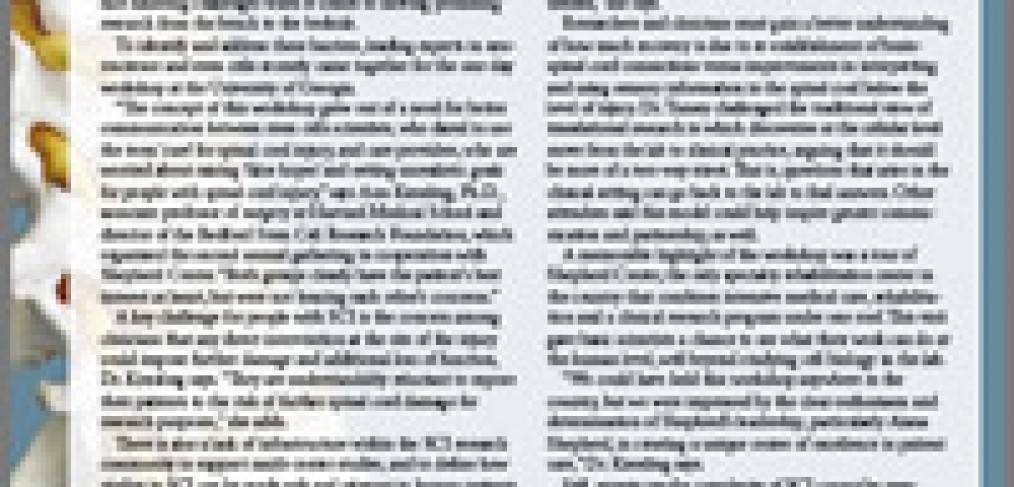
Leading experts in basic science and clinical care discuss barriers
Shepherd Center
From Bench to Bedside:
Leading experts in basic science and clinical care discuss barriers to a “cure” for spinal cord injury.
By Amanda Crowe, MA, mPH
It’s an exciting time for neuroscience, including the hope for new therapies to treat spinal cord injury (SCI). While basic scientists and clinicians are making important advances, they face daunting challenges when it comes to moving promising research from the bench to the bedside.
To identify and address these barriers, leading experts in neuroscience and stem cells recently came together for the one-day workshop at the University of Georgia.
“The concept of this workshop grew out of a need for better communication between stem cells scientists, who dared to use the term ‘cure’ for spinal cord injury, and care providers, who are worried about raising ‘false hopes’ and setting unrealistic goals for people with spinal cord injury,”says Ann Kiessling, Ph.D.,
associate professor of surgery at Harvard Medical School and director of the Bedford Stem Cell Research Foundation, which organized the second annual gathering in cooperation with Shepherd Center. “Both groups clearly have the patient’s best interest at heart, but were not hearing each other’s concerns.”
A key challenge for people with SCI is the concern among clinicians that any direct intervention at the site of the injury could impose further damage and additional loss of function, Dr. Kiessling says. “They are understandably reluctant to expose their patients to the risk of further spinal cord damage for research purposes,” she adds.
There is also a lack of infrastructure within the SCI research community to support multi-center studies, and to define how studies in SCI can be made safe and relevant to human patients. Keith Tansey, M.D., Ph.D., director of spinal cord injury research at Shepherd, spoke to the group about the need to ensure animal studies are more relevant to humans.
“Humans aren’t necessarily just big rats, and we need to better understand how and why animals are recovering from SCI because the mechanisms may not be the same in humans,” Dr. Tansey says. “Studies of animals and humans with incomplete injuries reveal a bias toward spinal plasticity in animals and brain plasticity in humans as the reason for functional recovery, so treatments may need to be different. In complete injuries, spinal circuits in rodents can regain stepping, but humans can’t, so we need to learn how to make human spinal cords function like rats’.”
Dr. Kiessling agrees, adding that animal model research needs to be more carefully aligned with human injuries and the out come goals for human therapies. “If walking is the outcome measure, animal models need to reflect that. But if bladder control is what’s important, a different animal model may be needed,” she says.
Researchers and clinicians must gain a better understanding of how much recovery is due to re-establishment of brainspinal cord connections versus improvements in interpreting and using sensory information in the spinal cord below the level of injury. Dr. Tansey challenged the traditional view of translational research in which discoveries at the cellular level move from the lab to clinical practice, arguing that it should be more of a two-way street. That is, questions that arise in the clinical setting can go back to the lab to find answers. Other attendees said this model could help inspire greater communication and partnership, as well.
A memorable highlight of the workshop was a tour of Shepherd Center, the only specialty rehabilitation center in the country that combines intensive medical care, rehabilitation and a clinical research program under one roof. This visit gave basic scientists a chance to see what their work can do at the human level, well beyond studying cell biology in the lab.
“We could have held this workshop anywhere in the country, but we were impressed by the clear enthusiasm and determination of Shepherd’s leadership, particularly Alana Shepherd, in creating a unique center of excellence in patient care,” Dr. Kiessling says.
Still, experts say the complexity of SCI cannot be overstated, and there is no silver bullet – no single cell, no single surgery, no single nerve-growth factor that will solve the whole riddle. “The more realistic expectation is that a combination of incremental steps is needed to improve recovery and maximize function,” Dr. Tansey says. “There is huge potential with stem cell biology and cell-replacement therapies, but there’s also a long distance between where we are today and where we need to be to find a ‘cure.’”
Collaborations among these leading experts will help forge the path forward. In the meantime, patients and their families should be encouraged by the progress made thus far, experts say. Prevention and early intervention, regeneration therapies at the cellular and extra-cellular levels and aggressive rehabilitation are all contributing to significant neurological recovery after SCI.
